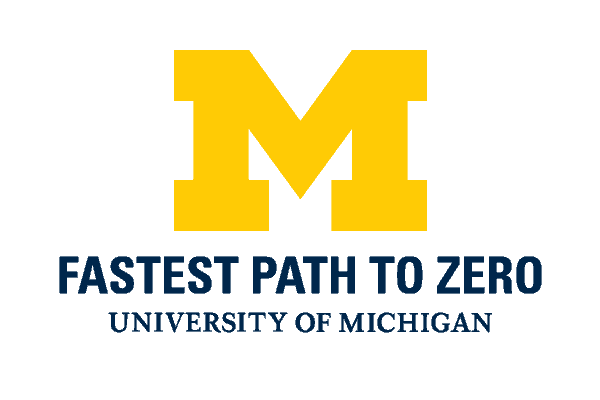Atomic Show #270 – Fastest Path to Zero

Suzanne (Suzy) Hobbs Baker serves as the Creative Director for Fastest Path to Zero. I recently spoke with Suzy and Steve Aplin, a consultant to the Canadian nuclear industry and frequent Atomic Show guest, about the work that Fastest Path to Zero has done and plans to do in the near future.
Fastest Path to Zero is an important initiative in the effort to dramatically reduce carbon dioxide emissions. Here is their concise self-description from the About page of their website.
We are an interdisciplinary team of experts, including University of Michigan staff and students, working to support communities as they plan and pursue ambitious climate goals. We offer a variety of tools to help communities transform their energy systems while adapting to a changing climate. Our tool belt includes big data analytics combined with a passion for human-centered design and engagement.
https://fastestpathtozero.umich.edu (accessed March 27, 2020)
Diversifying nuclear industry by adding sizes
Suzy had an another commitment, so she had to depart early. For the second part of the show, Steve and I talked about micro modular reactors that might find their initial customers in the northern, often First Nation, communities in Canada.
He provided an important perspective on some of the unique opportunities and challenges that developers might face when seeking to deploy their systems to serve that diverse, and quite small market.
We also discussed how nuclear system development in multiple sizes and configurations increases the usefulness of nuclear fission and diversifies the nuclear industry.
Nuclear industry organizations that specialize in large projects should not feel threatened by the influx of people whose talents and philosophical focus make them more suited to rapid deployment of much smaller systems involving smaller teams and serving customers with smaller power or heat needs.
I hope you enjoy the wide ranging discussion. Your comments and feedback are always appreciated.
Note: I apologize the occasional audio interruption. Systems like Skype are getting more use than usual a means of maintaining personal connections across social distance. Even in the virtual world, traffic can cause unexpected and uncomfortable slowdowns.
Podcast: Play in new window | Download (Duration: 1:03:11 — 72.4MB)
Subscribe: RSS


Please interview people, ask good questions, but don’t interrupt your guest and talk so much.
Zero isn’t good enough. Also required is removing the excess carbon dioxide from the atmosphere.
Zero is a phony number. There is no such thing as a zero carbon
grid. IPCC puts nuclear life cycle at 16 gCO2/kWh and
you will need some fossil fuel peaking
even in an “all” nuclear grid.
IPCC says PV solar is 48 gCO2/kWh. The all renewables
“zero” carbon grids typically have to install 5+ times
peak demand to be able to make a dubious claim that
they are reliable. That’s 250 g/CO2/kWh. And you will
need a boatload of batteries at 150 to 200 kg-CO2/kWh.
Even after adjusting for some decrease in these numbers
in a low carbon grid you are still a long, long way from zero.
With nuclear you can get reasonably close to zero.
A grid which attempts to be reliable by installing an enormous
amount of almost always surplus capacity will never get close.
Carbon capture and burial, if it can be done, will require enormous amounts of 24/7 power. It better be very low CO2 power or you will go backwards.
(This is a comment I’ve posted several places already, but here because it’s topical.)
Some very rough calculations on the olivine enhanced weathering solution to excess atmospheric CO2:
~500 billion tons CO2 removal required to return to 350 ppm.
1.25 tons CO2 removed per ton olivine weathered:
https://www.researchgate.net/profile/Oliver_Tickell/publication/48321940_Enhanced_weathering_of_olivine_to_capture_CO2/links/5694e75a08ae820ff0747619/Enhanced-weathering-of-olivine-to-capture-CO2.pdf
~400 billion tons dunite required
$15/ton dunite = $6 trillion total material cost
Assuming all cost is for electric power @ $0.05/kWh (very rough estimate):
300 kWh/ton dunite, 1.2e14 kWh total energy required
Spread over 20 years, that’s 684.5 GW average power.
This number could be high by a factor of 2; if energy at the reference mine costs $0.10/kWh instead of $0.05, the power requirement would fall to 342 GW average. Or there could be other costs which increase it somewhat. I’d bank on the number being within a factor of 2.
Another thing: A 60% efficient combined cycle plant burns 6 MJ of gas per kWh. At 50 MJ/kg LHV, that’s 0.12 kg of gas which burns to 0.330 kg of CO2. Producing 300 kWh in such a plant generates 99 kgCO2 (call it 100).
If it takes 300 kWh to mine and crush 1 ton dunite and it removes 1.25 tCO2 from the atmosphere, we can burn fossil fuel to power our CO2 removal systems and barely dent the positive effect.
This would be a big job, requiring the mining of literally cubic kilometers of ultramafic rock and distributing it as fine particles so they would weather quickly. But it’s doable. We CAN save the planet from our fossil fuel habit.
But will we?
Thank you to Steve Aplin for giving some insight about Inuit settlements and how they may not be ideal sites for deployment of nuclear reactors. I tried to phrase that uncharacteristically carefully. I found Steve’s reasoning very pragmatic and in line with my own thinking; I found Suzy’s reasoning to be – well – young.
I agree with Atomic Rod’s closing comments with regards to COVID19 – that modern humanity’s response (total shutdown) has been out of proportion to the severity threat. This type of behavior parallels the challenges inhibiting wider application of nuclear power – fear rules all decisions.